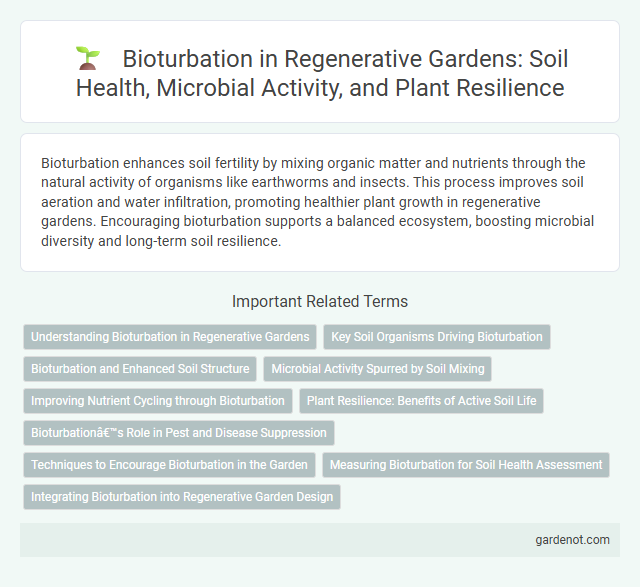Bioturbation enhances soil fertility by mixing organic matter and nutrients through the natural activity of organisms like earthworms and insects. This process improves soil aeration and water infiltration, promoting healthier plant growth in regenerative gardens. Encouraging bioturbation supports a balanced ecosystem, boosting microbial diversity and long-term soil resilience.
Understanding Bioturbation in Regenerative Gardens
Bioturbation in regenerative gardens involves the natural process where soil organisms like earthworms, insects, and microbes mix and aerate the soil, enhancing soil structure and fertility. This biological activity improves water infiltration, nutrient cycling, and root growth, promoting a healthy, resilient garden ecosystem. Understanding and encouraging bioturbation supports sustainable soil management and boosts plant productivity in regenerative gardening practices.
Key Soil Organisms Driving Bioturbation
Earthworms, termites, and ants are key soil organisms driving bioturbation, significantly enhancing soil structure and nutrient cycling in regenerative gardens. Their burrowing activities increase aeration, improve water infiltration, and facilitate organic matter decomposition, promoting healthy plant growth. These organisms create channels that support root penetration and microbial diversity, essential for maintaining fertile and resilient soil ecosystems.
Bioturbation and Enhanced Soil Structure
Bioturbation, the natural process of soil mixing by organisms such as earthworms and insects, significantly enhances soil structure by increasing aeration and promoting nutrient cycling. This improved soil porosity boosts water infiltration and root penetration, fostering healthier plant growth in regenerative gardens. Enhanced soil structure through bioturbation supports microbial activity, which is essential for sustainable soil fertility and carbon sequestration.
Microbial Activity Spurred by Soil Mixing
Bioturbation significantly enhances microbial activity by mixing soil layers, which increases oxygen penetration and nutrient availability, fostering microbial growth and diversity. This intensified microbial activity accelerates organic matter decomposition and nutrient cycling, crucial for soil fertility in regenerative gardens. Enhanced microbial ecosystems improve soil structure and plant health, creating a sustainable environment for regeneration.
Improving Nutrient Cycling through Bioturbation
Bioturbation, the natural process of soil mixing by organisms such as earthworms and insects, enhances nutrient cycling by aerating the soil and breaking down organic matter. This activity increases the availability of essential nutrients like nitrogen and phosphorus, promoting healthier plant growth in regenerative gardens. Improved nutrient cycling through bioturbation supports soil fertility, boosts microbial activity, and sustains ecosystem resilience.
Plant Resilience: Benefits of Active Soil Life
Bioturbation enhances plant resilience by promoting active soil life that improves nutrient cycling and aeration. Earthworms, insects, and microorganisms create channels in the soil, increasing water infiltration and root penetration essential for robust plant growth. This dynamic soil environment supports regeneration and reduces plant stress from drought and pathogens.
Bioturbation’s Role in Pest and Disease Suppression
Bioturbation enhances soil health by promoting microbial diversity and aeration, which suppresses pest and disease populations in regenerative gardens. Earthworms and soil-dwelling organisms disrupt pest habitats, reducing the prevalence of harmful pathogens. This natural soil activity fosters resilient plant growth and decreases the need for chemical interventions.
Techniques to Encourage Bioturbation in the Garden
Incorporating organic mulch layers and diverse soil fauna habitats promotes bioturbation by stimulating earthworm and microbe activity essential for soil aeration and nutrient cycling. Applying compost teas and avoiding synthetic pesticides support a thriving soil ecosystem, enhancing natural bioturbation processes. Implementing no-till gardening and crop rotations further encourages soil organism movement, improving soil structure and fertility through biological mixing.
Measuring Bioturbation for Soil Health Assessment
Measuring bioturbation involves quantifying soil mixing activities by organisms such as earthworms, insects, and roots to evaluate soil health and aggregate stability. Techniques include using tracers like colored sand or isotopes, visual soil profile analysis, and assessing soil porosity and nutrient distribution changes. These metrics provide critical insights into soil ecosystem functioning, aeration, and organic matter decomposition essential for regenerative garden management.
Integrating Bioturbation into Regenerative Garden Design
Integrating bioturbation into regenerative garden design enhances soil health by promoting natural aeration and nutrient cycling through the activity of soil organisms like earthworms and insects. This process improves soil structure, water retention, and microbial diversity, leading to increased plant vitality and resilience. Designing gardens that support bioturbation involves incorporating organic matter, minimizing soil disturbance, and creating habitats that encourage beneficial soil fauna.
Bioturbation Infographic

 gardenot.com
gardenot.com